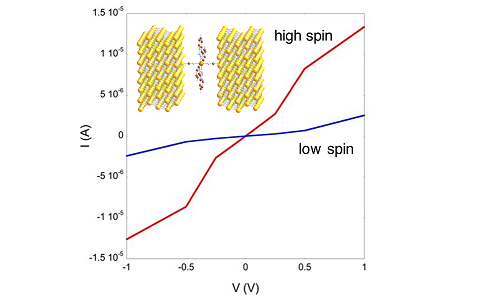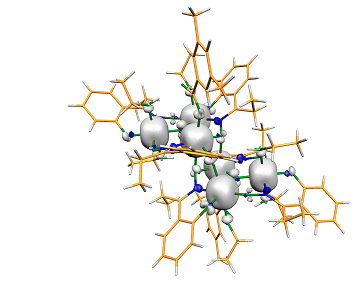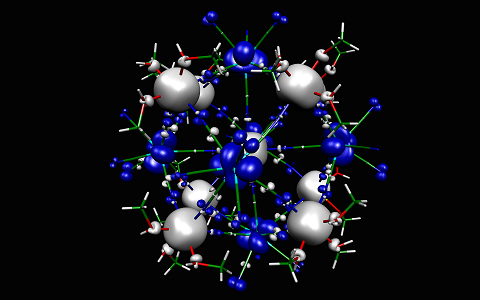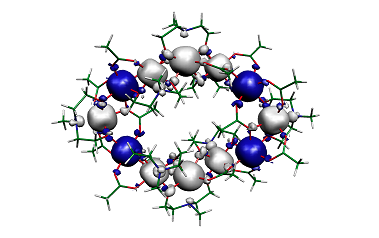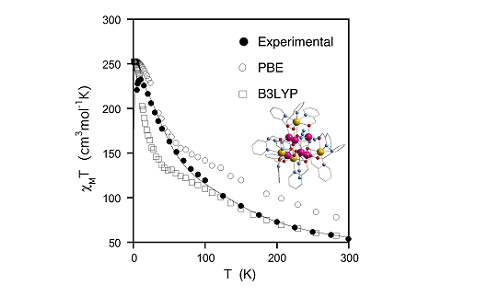Researchers
Prof. Eliseo Ruiz
Some polynuclear transition metal complexes, known as single molecule magnets (SMM), show a slow relaxation of the magnetization and, as a result, each individual molecule behaves as a magnet. Hence, SMM’s have been proposed either as potential materials for information storage at the molecular level or as qubits in quantum computers, due to their quantum-controlled spin flip. In this field, the Holy Grail is an SMM with a high enough spin inversion barrier to avoid both the thermal spin flip and quantum tunneling effects. The synthesis of new SMMs is a serendipitous search for large energy barriers (large total spin and large and negative magnetic anisotropy). However, theoretical methods allow us to understand and rationalize the experimental data and to point out new synthetic targets. The use of electronic structure calculations allows to determine all the exchange coupling constants present in the same as well as the magnetic anisotropy that is usually quantified by means of the zero-field splitting parameters. Also, low-spin magnetic molecules have been also proposed as molecular qubits. Our research is focusing on the spin relaxation properties of such systems, in order to extract qualitative predictions about the coherence time of such systems. In our group, we are performing both the theoretical studies and the experimental synthesis and characterization of SMM systems.
Relevant Publications
| M. Ding, G. E. Cutsail III, D. Aravena, D.; M. Amoza, M. Rouzieres, P. Dechambenoit, Y. Losovyj, M. Pink, E. Ruiz, R. Clérac and J. M. Smith. «A low spin manganese(iv) nitride single molecule magnet.» Chem. Sci. 2016, 7, 6132-6140. Doi: 10.1039/C6SC01469K |
| S. Gómez-Coca, E. Cremades, N. Aliaga-Alcalde, E. Ruiz, “Huge Magnetic Anisotropy in a Trigonal-Pyramidal Nickel(II) Complex”, Inorg. Chem. 2014, 53, 676-678. |
| D. Aravena, E. Ruiz. «Shedding Light on the Single-Molecule Magnet Behavior of Mononuclear DyIII Complexes», Inorg. Chem. 2013, 52, 13770-13778. |
| E. Colacio, J. Ruiz, E. Ruiz, E. Cremades, J. Krzystek, S. Carretta, J. Cano, T. Guidi, W. Wernsdorfer, E. K. Brechin. «Slow Magnetic Relaxation in a Co(II)-Y(III) Single-Ion Magnet with Positive Zero-Field Splitting», Angew. Chem. Int. Ed. 2013, 52, 9130-9134. |
| S. Gómez-Coca, E. Cremades, N. Aliaga-Alcalde, E. Ruiz. «Mononuclear Single-Molecules Magnets: Tailoring the Magnetic Anisotropy of First-Row Transition-Metal Complexes», J. Am. Chem. Soc. 2013, 135, 7010-7018. |
| E. Cremades, S. Gomez-Coca, D. Aravena, S. Alvarez, E. Ruiz, “Theoretical Study of Exchange Coupling in 3d-Gd Complexes: Large Magnetocaloric Effect Systems”, J. Am. Chem. Soc. 2012, 134, 10532−10542 |
| J. Cirera, E. Ruiz, S. Alvarez, F. Neese and J. Kortus, «How to Build Molecules with Large Magnetic Anisotropy», Chem. Eur. J. 2009, 15, 4078-4087. |
| E. Ruiz, T. Cauchy, J. Cano, R. Costa, J. Tercero and S. Alvarez, «Magnetic structure of the large-spin Mn10 and Mn19 complexes: A theoretical complement to an experimental milestone», J. Am. Chem. Soc. 2008, 130, 7420-7426. |
| T. Cauchy, E. Ruiz and S. Alvarez, «Magnetostructural correlations in polynuclear complexes: The Fe4 butterflies», J. Am. Chem. Soc. 2006, 128, 15722-15727. |
| E. Ruiz, J. Cano, S. Alvarez and P. Alemany, «Magnetic coupling in end-on azido-bridged transition metal complexes: A density functional study», J. Am. Chem. Soc. 1998, 120, 11122-11129. |
| E. Ruiz, P. Alemany, S. Alvarez and J. Cano, «Toward the prediction of magnetic coupling in molecular systems: Hydroxo- and alkoxo-bridged Cu(II) binuclear complexes», J. Am. Chem. Soc. 1997, 119, 1297-1303. |
All Publications of Magnetic Properties of Complex Inorganic Systems.

